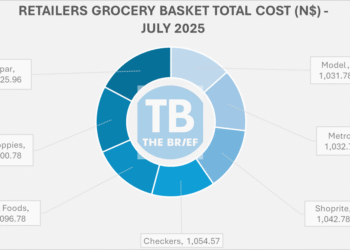
Growth in Namibia’s mining sector is not expected to result in an increase in employment, wage growth, or consumption spending, as the sector only contributes 1.8% to total employment.
Namibia’s growth averaged 5.6% in the first three quarters of 2022, making it the highest growth since 2015, with mining-led growth averaging 21.9% during the same period, according to FirstRand Namibia’s Economist Ruusa Nandango.
“Growth was predominantly mining-sector led as that sector’s growth averaged 21.9% during the same period, while other sectors grew at a much lower rate than mining. The growth was therefore concentrated around mining activities and not broad-based across the various sectors of the economy. Given that mining only contributes 1.8% to total employment, we do not expect that the mining-led growth will necessarily translate to a significant increase in employment, wage growth, and consumption spending,” Nandango told a recently held investment summit.
According to the economist, manufacturing recorded 10.2% growth during the period under review, financial services 9.7%, and health 8.8%. Negative growth was recorded in the country’s construction sector at -14.2%, followed by public administration at -2.6%, Agriculture and Forestry at -1.5%, including fishing at 0.7%.
Giving more insight into the economic landscape, Nandango said inflation also rose exponentially mainly driven by food at a staggering 14% and fuel at 11%. The national inflation rate is at 7.2%. The economist raised concern about the national debt that is forecasted to reach a record high of N$150 billion, accounting for 60% of GDP.
Nandango was, however, hopeful that redoubled tax collections and the Southern African Customs Union (SACU) revenues will boost the country’s fiscal position, although warning against the country’s overreliance on income from the trade block.
“This affects proper fiscal planning because the SACU mechanism is set up in such a manner that such revenues are paid in advance, and if you get to the end of the year, and your projections do not match, then when you are short as a country, you need to pay back into the pool. So it is important to make sure that by the end of the year, you have these revenues so that you don’t complicate your fiscal management,” she said.
Ashburton Namibia CEO Taimi Shejavali said the summit comes on the backdrop of exciting developments in the country’s investment opportunities, with the recent discovery of oil, implementation of green hydrogen projects, and overall improvements in the economy.
 “Despite global economic disruptions caused by the COVID-19 pandemic, Namibia has maintained a positive outlook and continues to offer key advantages for direct investment,” Shejavali said.
“As Ashburton, we are here to show that we are determined to build a country that is driven by enterprise and innovation, to develop an economy that is diverse, resilient, and prosperous, and to create opportunities that achieve sustained returns not only for our clients but also for the communities that support them,” she said.
Shejavali said Namibia has the right conditions to focus on accelerating economic development, adding that the country can capitalize on improvements in the economy to address remaining challenges in attracting investment.
 “As a long-standing partner in development, Ashburton is committed to supporting Namibia in its journey to economic emancipation,” she said.
The summit, the first of its kind for Ashburton, discussed topics ranging from the state of the Namibian and global economies, opportunities for investment, and Ashburton products, services, as well as solutions for investors
Â
Â
Â











